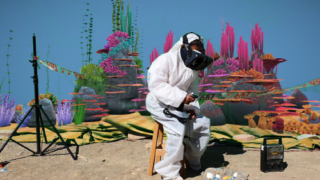
Bethesda_defrag 2021
HD video, 22’32”
Commissioned for Rethinking Nature
Courtesy of the artist
Francois Knoetze is a performance artist, sculptor and filmmaker known for his sculptural suits and video essays on technological futures. Bethesda_defrag operates at the intersection of artistic research, pedagogy, speculation, activism and filmmaking. Set in the small farming town of Nieu Bethesda in the South African Karoo desert, which boasts the most undisturbed fossil record in the world, including relics from three previous extinction events, the work is a meditation on the forced displacement from land and resistance against the erasure of collective memory. It speculates about images preserved on a fossilized hard drive and unfolds the know between ecocide and genocide. Attempting to re-situate the disciplines of geology and paleontology, Knoetze analyses how White geology continues to propagate imaginaries that organise Blackness as a stratum and barrier to resource extraction, and also how political and academic regimes consider indigenous people as ‘living fossils’, surviving out of time as representatives of human ancestors, or living natural history. The work unravels the violence inherent in the throughgoing imposition in European Enlightenment philosophy of a division between nature and culture that plays out along racial lines and enables the extraction of resources and labour. Knoetze combines archival material with documentation of a workshop series which involved local community members, fossil guides, climate activists and children. Drawing on critical theory from Kathryn Yusoff, Mohamed Adhikari and Alexis Pauline Gumbs, Bethesda_defrag moves beyond the immediate threats to the town’s fragile ecology to trace the origins of the contemporary climate crisis, document human acts of survival, and imagine possible futures.
Artist’s statement
I like to think of the videos I create as psycho-geographic essays or rhizomatic constellations that viewers can wander through, finding their own connections. As a scavenger of found materials, I’m interested in the imprints and traces things leave, how the Earth is an archive of past activity and processes on its surface. I spent my childhood watching television and playing computer games, which has made me acutely aware of the ideologies embedded in mass media, such as the pervasive green rhetoric of the 90s, which enthusiastically sought to environmentalize kids. In my work, I try to unpick simplistic, individualistic solutions for complex problems. Today it seems that the most hopeful future in the public mainstream is abandoning Earth to colonize Mars, or else becoming immortal and uploading our minds into machines. The same people responsible for climate change are the ones buying the tickets to Mars or building bunkers. In the face of the climate crisis, in recent years the knowledge of local and indigenous people has been recognized as an important source of climate knowledge and adaptation strategies. I think that rethinking nature calls for radical acts of imagination, calls for reimagining how we relate to the land upon which we stand, the traces we leave and the connections we make.